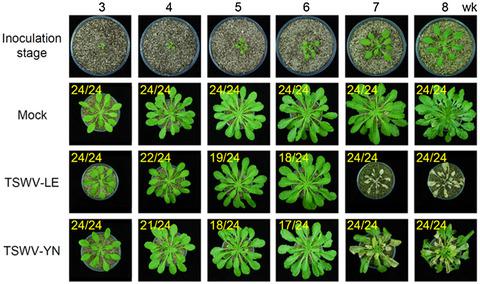当前位置:
X-MOL 学术
›
Mol. Plant Pathol.
›
论文详情
Our official English website, www.x-mol.net, welcomes your
feedback! (Note: you will need to create a separate account there.)
Developmentally regulated Arabidopsis thaliana susceptibility to tomato spotted wilt virus infection.
Molecular Plant Pathology ( IF 4.8 ) Pub Date : 2020-05-22 , DOI: 10.1111/mpp.12944 Ying Huang 1 , Hao Hong 1 , Min Xu 1 , Jiaoling Yan 1 , Jing Dai 1 , Jianyan Wu 1 , Zhike Feng 1 , Min Zhu 1 , Zhongkai Zhang 2 , Xuefeng Yuan 3 , Xinshun Ding 1 , Xiaorong Tao 1
Molecular Plant Pathology ( IF 4.8 ) Pub Date : 2020-05-22 , DOI: 10.1111/mpp.12944 Ying Huang 1 , Hao Hong 1 , Min Xu 1 , Jiaoling Yan 1 , Jing Dai 1 , Jianyan Wu 1 , Zhike Feng 1 , Min Zhu 1 , Zhongkai Zhang 2 , Xuefeng Yuan 3 , Xinshun Ding 1 , Xiaorong Tao 1
Affiliation

|
Tomato spotted wilt virus (TSWV) is one of the most devastating plant viruses and often causes severe crop losses worldwide. Generally, mature plants become more resistant to pathogens, known as adult plant resistance. In this study, we demonstrated a new phenomenon involving developmentally regulated susceptibility of Arabidopsis thaliana to TSWV. We found that Arabidopsis plants become more susceptible to TSWV as plants mature. Most young 3‐week‐old Arabidopsis were not infected by TSWV. Infection of TSWV in 4‐, 5‐, and 6‐week‐old Arabidopsis increased from 9%, 21%, and 25%, respectively, to 100% in 7‐ to 8‐week‐old Arabidopsis plants. Different isolates of TSWV and different tospoviruses show a low rate of infection in young Arabidopsis but a high rate in mature plants. When Arabidopsis dcl2/3/4 or rdr1/2/6 mutant plants were inoculated with TSWV, similar results as observed for the wild‐type Arabidopsis plants were obtained. A cell‐to‐cell movement assay showed that the intercellular movement efficiency of TSWV NSm:GFP fusion was significantly higher in 8‐week‐old Arabidopsis leaves compared with 4‐week‐old Arabidopsis leaves. Moreover, the expression levels of pectin methylesterase and β‐1,3‐glucanase, which play critical roles in macromolecule cell‐to‐cell trafficking, were significantly up‐regulated in 8‐week‐old Arabidopsis leaves compared with 4‐week‐old Arabidopsis leaves during TSWV infection. To date, this mature plant susceptibility to pathogen infections has rarely been investigated. Thus, the findings presented here should advance our knowledge on the developmentally regulated mature host susceptibility to plant virus infection.
中文翻译:

发育调控的拟南芥对番茄的斑萎病毒感染敏感性。
番茄斑萎病病毒(TSWV)是最具破坏性的植物病毒之一,通常会在全球范围内造成严重的农作物损失。通常,成熟植物对病原体的抵抗力增强,被称为成年植物抵抗力。在这项研究中,我们证明了一种新现象,涉及拟南芥对TSWV的发育调控敏感性。我们发现随着植物的成熟,拟南芥植物对TSWV的敏感性更高。大多数三周大的拟南芥没有被TSWV感染。在4- TSWV的感染,5-,和6-周龄拟南芥分别从9%,21%和25%,增加至100%在7至8周龄的拟南芥植物。TSWV的不同分离物和不同的弓形病毒在拟南芥中的感染率较低,而在成熟植物中的感染率较高。当用TSWV接种拟南芥dcl2 / 3/4或rdr1 / 2/6突变植物时,得到的结果与野生型拟南芥植物相似。的细胞-细胞移动试验显示TSWV NSM的细胞间移动效率:GFP融合是显著高于8周龄拟南芥叶子4周龄相比拟南芥叶子。此外,果胶甲基酯酶和β-1,3-葡聚糖酶的表达水平,从而起到大分子细胞与细胞运输的关键作用,是显著在8周龄上调拟南芥叶与4周龄相比拟南芥TSWV感染过程中的叶子。迄今为止,很少研究这种成熟植物对病原体感染的敏感性。因此,这里提出的发现将使我们对发育受调控的成熟宿主对植物病毒感染的敏感性提高我们的知识。
更新日期:2020-05-22
中文翻译:

发育调控的拟南芥对番茄的斑萎病毒感染敏感性。
番茄斑萎病病毒(TSWV)是最具破坏性的植物病毒之一,通常会在全球范围内造成严重的农作物损失。通常,成熟植物对病原体的抵抗力增强,被称为成年植物抵抗力。在这项研究中,我们证明了一种新现象,涉及拟南芥对TSWV的发育调控敏感性。我们发现随着植物的成熟,拟南芥植物对TSWV的敏感性更高。大多数三周大的拟南芥没有被TSWV感染。在4- TSWV的感染,5-,和6-周龄拟南芥分别从9%,21%和25%,增加至100%在7至8周龄的拟南芥植物。TSWV的不同分离物和不同的弓形病毒在拟南芥中的感染率较低,而在成熟植物中的感染率较高。当用TSWV接种拟南芥dcl2 / 3/4或rdr1 / 2/6突变植物时,得到的结果与野生型拟南芥植物相似。的细胞-细胞移动试验显示TSWV NSM的细胞间移动效率:GFP融合是显著高于8周龄拟南芥叶子4周龄相比拟南芥叶子。此外,果胶甲基酯酶和β-1,3-葡聚糖酶的表达水平,从而起到大分子细胞与细胞运输的关键作用,是显著在8周龄上调拟南芥叶与4周龄相比拟南芥TSWV感染过程中的叶子。迄今为止,很少研究这种成熟植物对病原体感染的敏感性。因此,这里提出的发现将使我们对发育受调控的成熟宿主对植物病毒感染的敏感性提高我们的知识。











































 京公网安备 11010802027423号
京公网安备 11010802027423号